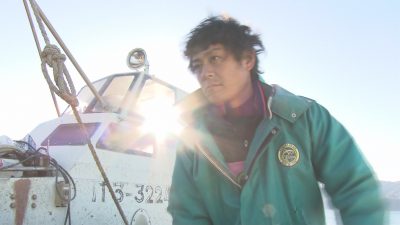Akahama Rock'n Roll
赤浜ロックンロール
Konishi Haruko
Japan/90min./2015
 This film depicts man’s pride as they live with the sea, grateful for its blessings while accepting its many risks.
This film depicts man’s pride as they live with the sea, grateful for its blessings while accepting its many risks.The forest, rivers and groundwater nurture the sea of Otsuchi-cho. Otsuchi-cho is located in the center of Tohoku region of Japan. The spring water also flows from the seabed of Otsuchi Bay.
On March 11, 2011, an earthquake with a magnitude of 9.0 and up to 22-meter high tsunami struck Otsuchi-cho. Of the 15,000 population, 1,281 people died or were reported missing. 85 percent of the town was lost.
Central government proposed plan to construct 14.5-meter embankment to protect Tsunami. However, Hiromi Kawaguchi, chairman of the Akahama Residents’ Committee, refused the government’s plan and made them accept his original plan. He lost his mother, wife and grandson to the tsunami. He believes that “Nature cannot be controlled by man. For future generations, we must build our homes on higher ground.”
Tsutomu Abe, head of Fishermen’s Cooperative Association, is devoting all his energies into delivering high-quality seafood as specialty products by taking advantage of the excellent fishing grounds. Abe believes that “We must live with nature and its blessings. We do not need huge man-made structure.”
Both Abe and Kawaguchi differ from those who believe in controlling nature with power and money. This film takes place in a small, disaster-stricken rural area. However, this is a just smaller version of problems that can be found in other places of the world. ‘Development vs. nature conservation’, ‘first principle of economics vs. sustainable living’.
Both Abe and Kawaguchi differ from those who believe in controlling nature with power and money. This film takes place in a small, disaster-stricken rural area. However, this is a just smaller version of problems that can be found in other places of the world. ‘Development vs. nature conservation’, ‘first principle of economics vs. sustainable living’.
| Title in English | Akahama Rock'n Roll |
|---|---|
| Title in Original Language | 赤浜ロックンロール |
| Director(s) | Konishi Haruko |
| Director's Bio/Filmography | Konishi Haruko directed “The Documentarist”, a TV series on documentarists and produced the film “Little Birds”, which was awarded the Human Rights Prize in the Locarno International Film Festival 2005. She also produced the film “Peace on the Tigris - Iraq War and 10 years of life in Baghdad-” as a sequel to “Little Birds” after ten years. The film ”Akahama Rock’n Roll” is the first feature film she directed and is supported by Agency for Cultural Affairs. |
| Year of Completion | 2015 |
| Nationality of the Film | Japan |
| Running Time | 90 min. |
| Aspect Ratio | Video: 16:9 |
| Color | Color |
| Screening Format | BD |
| Shooting Locations | Japan, Iwate Prefecture |
| Shooting Dates/Periods | August 1, 2011- March 2015 |
| Names of Characters | Kawaguchi Hiromi, Abe Tsutomu |
| Language of Commentary and Dialogue | Japanese, |
| Subtitles | English, |
| Date of First Public Screening | 2015/5/2 |
| Place of First Public Screening (Country) | May 2, 2015 |
| Date of First Public Screening in Japan | 2015/5/2 |
| Previous Screenings at Other Film Festivals and Events | K's Cinema (Tokyo, Japan) |
| Staff Credits |
Photography: Furuto Hidehiko, Konishi Haruko Editing: Tsujii Kiyoshi Sound: Watanabe Takehiko |
| Producer | Konishi Haruko, Yasuoka Takeharu |
| Distributor / Distribution Company | Uzumasa Corporation |
| Official Website for the Film | http://www.u-picc.com/akahama_rocknroll/ |
| Other Online Access to the film | http://www.facebook.com/AkahamaRocknRoll/ |
| Screenings at the Past YIDFF Programs and Events | None |

